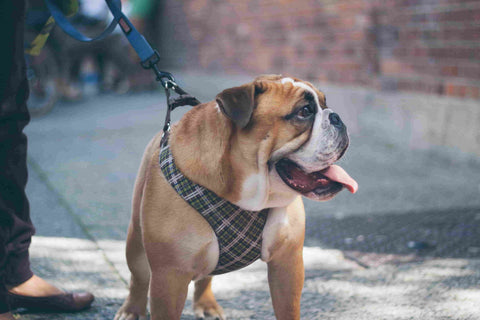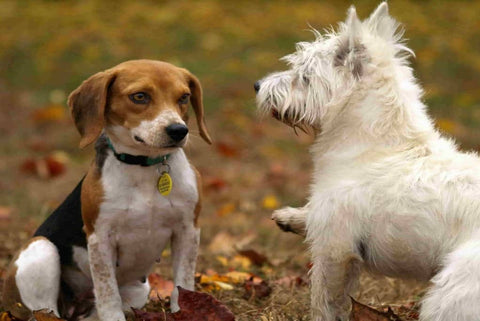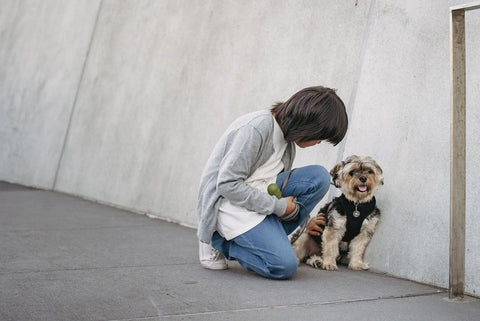What's the Best Harness for a Medium Dog?
A harness is one of the best items you’ll ever buy for your dog. With a proper fit and a high-quality design, harnesses can become training tools, and they improve safety and comfort. For medium dogs and especially when they’re very active during walks, harnesses offer additional control, so you feel comfortable.
If you’re ready to look for a harness for your medium dog, we walk you through everything you need to know. Learn how to find the right fit and choose the best option for you and your dog!
Which Breeds Fit Medium Dog Harnesses?
When we use the term medium-sized dog, we’re often talking about a weight ranging from 30 to 50 pounds. The chest girth of a medium dog may range from 22 to 27 inches. Breeds that tend to fit well in a medium-sized harness include:
- Beagle
- Border Collie
- Boston Terrier
- English Bulldog
- French Bulldog
Check out the full list of medium-sized dog breeds here.
While there are certain breeds that are more likely to fit in medium harness, this isn’t always true. Some breeds may have a broader chest, for example, which means they could need a size up in their harness. That’s why it’s so important to get precise measurements that you can then compare to Pet&Cuddle’s size charts. We encourage you to follow our step-by-step instructions to measure your dog for the perfect harness fit.
How to Choose the Right Harness
When you’re choosing the right harness for your medium dog, you’ll use a few key measurements. You’ll then need to decide on the best type of harness for your needs, and also make sure you’re buying from a reputable company like Pet&Cuddle that prioritizes both comfort and safety.
Select the Type
There are a few different types of harnesses for medium dogs, including:
- Back-Clip Harness: A back clip harness features a D-ring clip, which is the leash attachment, at the top back. This type of harness is easy to use, and it’s suited to a dog that’s well-trained. Back clip harnesses are a good option if your dog doesn’t have a tendency to pull too.
- Step-In Harness: A dog steps into one of these, with both front paws. Then, the harness fastens at his back. A step-in harness is an alternative to one that goes over the head, which some dogs don’t like. Some are designed to be more difficult to escape from than an over-the-head option, and these harnesses form triangles at your dog’s legs rather than rectangles. Leash clips are usually located at the back.
- Front-Clip Dog Harness: This option has a leash clip at your dog’s front, and it’s good for training. A front-clip harness creates the feeling of a barrier if a dog tries to push forward, pull or lunge. That’s why a front-clip option is often called a no-pull harness. There’s a sense of tension at the shoulder blades that stops the pulling impulse.
- Dual-Clip Dog Harness: We highly recommend a dual-clip harness because it gives the versatility of both a front and back harness. You can use it for a variety of activities, including training and leisurely walks. Use the front clip when you’re training, and when your dog’s ready, switch to the back clip.
Measure Your Dog to Get the Right Size
To measure your dog, you’ll need a tape measure. Then, follow the steps below:
Step 1: Measure your dog’s neck. Use your tape measure around the base of the neck where a traditional collar would typically go. This is the base of the neck or the widest point. Wrap the tape measure around to meet itself.
Step 2: Use your tape measure to get the size of the broadest part of your dog’s chest. That’s usually the point just behind the armpits. Wrap your tape measure around the chest and over his back. Don’t try to make the tape measure too tight.
Step 3: For belly girth, measure starting about an inch in front of the rear legs. Wrap your tape measure around the widest part of your dog’s belly.
Step 4: Check your dog’s body length. Start just behind your dog’s front leg, and then bring your tape measure directly behind his rear leg.
It can also be helpful to get your dog’s weight, and then when you have these measurements, you can visit the Pet&Cuddle website and check our size charts. If your dog is on the edge for a size, we recommend that you go up and get the larger option.
When you have your harness, there are a few things to do to make sure it’s correctly sized. First, make sure you can slide two fingers under any two straps throughout the harness. It should be snug, but not so tight you can’t do this. Then you should try to pull the harness over your dog’s head. If you can do it, then it’s too loose.
Achieve a Proper Fit
Before you use your new dog harness, complete the following steps to ensure that it’s a perfect fit.
- Put the harness on your dog, clipping it together. It should sit a couple of inches below where a collar would, flat on the body.
- Adjust the straps so that there’s a close fit but not too tight. Your dog should be able to freely move in his harness without any restriction. Straps shouldn’t be drooping or seeming to dig into your dog’s skin.
- If your dog is well-trained and doesn’t pull, attach a leash to the back ring. If your dog isn’t well-trained, use the front ring initially.
What Features Should You Look for in a Dog Harness?
You always want the best for your dog, so if you’re taking your time and comparing the many harness options, features to look for include:
- Safety: At Pet&Cuddle, our harness designs are created with safety as the number one priority. Make sure you choose an option prioritizing safety. Compared to a collar, dog harnesses have a lower risk of injury and choking, which is why we prefer them.
- Easy to use: If you’re struggling to get it on and off, you’re going to walk your dog less, and that’s not good for his mental or physical well-being. Choose a harness that you can use easily and take on and off quickly.
- Adjustable: We touched above on the importance of adjusting the belts of harnesses so that you get a perfect customized fit for your dog. Every dog is built differently, so even after using measurements, adjustability is key for comfort.
- Weight: Choose a lightweight harness that you can easily take anywhere you go.
- Clip Location: The clips are also referred to as D-rings, and you should choose based on how well-trained your dog is. Again, we prefer a dual-clip harness, so you get flexibility in how you use it.
- Reflective materials: Do you love taking a walk early in the morning before the sun comes up, or perhaps in the evening? If so, make sure your dog’s harness has reflective materials for both of your safety.
Is It Okay to Use a Retractable Leash for a Medium Dog Harness?
We tend to hear from customers that they worry they can’t use a retractable leash with a harness, and that’s not the case! In fact, using a retractable leash with a harness is a good option, but with a few things in mind.
Using a retractable dog leash is more convenient and easier than a fixed-length leash. A retractable leash pairs especially well with the top clip of your dog’s harness. You can use them together without concerns about safety. However, if you have a front-clip harness and you’re using a retractable leash, do so carefully.
When you use a retractable leash with a front clip, you’re putting constant tension on it since the leash line won’t go slack. That could be uncomfortable and may encourage your dog to show more bad walking behavior. Giving the leash line some slack will help.
Should You Really Use a Harness for Medium Dogs?
Benefits of using a harness for your medium-sized dog include:
- Control: When you use a harness for your medium dog, the additional attachment and the pressure points distributed around the body give you more control. That can help you stay calmer and more relaxed on your walks, making them enjoyable for you and your dog.
- Training: If you choose a no-pull harness with a front clip, you can use it to train your dog to stop pulling while you’re on walks.
- Safety: It’s much harder to escape from a harness, and it reduces the pressure on the neck. Instead, pressure is evenly distributed in multiple points across your dog’s body, lowering the potential for an injury.
- Comfort: Traditional collars can be stressful for a dog to wear because they put pressure on the neck and trachea, which a harness doesn’t.
We, the Pet&Cuddle dog lovers, are constantly creating new dog harness collections, which are safe, multifunctional, and effective for training, leading, or adapting purposes.
Discover the latest dog harness collection we created exactly for your dog here.
Questions About Using Harnesses for Medium Dogs
We love being able to answer questions people have about all things related to their dogs. That includes questions about harnesses for medium dogs. With that in mind, below, we put together a guide with answers to some of the questions we most often get.
Are Harnesses More Secure for Medium Dogs?
There are a few reasons harnesses are more secure for a medium dog than a collar. First, it’s easy to slip out of a collar. The way a harness is worn greatly reduces this risk.
Since there isn’t pressure concentrated at your dog’s neck only, the potential for injury is also less with a harness compared to a collar.
Dog harnesses are versatile and work for different activities, and they provide you with the added benefit of more control and helpful training features.
Are Harnesses Safer for Medium Dogs?
Harnesses are safer for medium dogs than a collar. Harnesses reduce pressure on the neck and make it more difficult for your dog to slip out. They’re also generally more comfortable and provide you with more control.
Are Harnesses More Comfortable for Medium Dogs?
When compared to traditional collars, a harness reduces the pressure that would be put on just the neck. As a result, there’s no feeling of choking with a harness like there is when you use a typical collar. A collar puts every bit of applied pressure at one part of your dog’s neck.
What Age Can Dogs Start Using a Harness?
Since they are an effective training tool, you should aim to use a dog harness as soon as you get the go-ahead from your vet. Most vets will recommend waiting until your puppy is around eight months old to start using a leash. The most important thing to keep in mind is that you should get the right fit.
When Should You Use a Harness?
Thanks to the comfort, safety, and versatility, you can use a harness in any situation. You can use them for walks in both open spaces and more crowded areas. Dog harnesses can be used for hiking or other activities, and you can also use them for training and teaching your dog not to pull.
Do Harnesses Encourage Pulling?
Harnesses don’t encourage pulling. In fact, they do just the opposite, especially if you use the front clip. If your dog does pull, then it may be an indicator you have the wrong size or that your dog needs more time to adjust to it.
Get the Medium Dog Harness from Pet&Cuddle
With a harness, it becomes much easier to do various activities such as walking, training, or playing with your dog. If you have already decided to buy one - take your dog's measurements and pick up your right dog harness now. Besides, our Pet&Cuddle experts can help you to choose a safe and comfortable dog harness with a unique design.
We, the Pet&Cuddle dog lovers, are constantly creating new dog harness collections, which are safe, multifunctional, and effective for training, leading, or adapting purposes.
Discover the latest dog harness collection we created exactly for your dog here.



